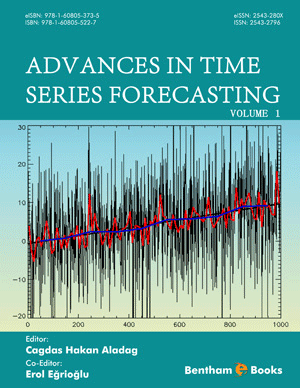Introduction to Statistics
Page: 1-8 (8)
Author: Alandra Kahl*
DOI: 10.2174/9789815123135123010002
PDF Price: $15
Abstract
The field of statistics is vast and utilized by professionals in many
disciplines. Statistics has a place in science, technology, engineering, medicine,
psychology and many other fields. Results from statistical analysis underlying both
scientific and heuristic reasoning, and therefore, it is important for everyone to grasp
basic statistical methods and operations. A brief overview of common statistical
methods and analytical techniques is provided herein to be used as a reference and
reminder material for professionals in a broad array of disciplines.
Summarizing and Graphing
Page: 9-25 (17)
Author: Alandra Kahl*
DOI: 10.2174/9789815123135123010003
PDF Price: $15
Abstract
Data captured during analysis can be easily summarized using visual
techniques such as graphing. Graphing is utilized to both summarize and convey
information in a clear and readable format. Graphing techniques discussed in this
chapter include frequency distributions, histograms, box plots and Pareto charts.
Basic Concepts of Probability
Page: 26-52 (27)
Author: Alandra Kahl*
DOI: 10.2174/9789815123135123010004
PDF Price: $15
Abstract
A commonly used statistical measure is the measurement of probability.
Probability is governed by both additive and multiplicative rules. These rules determine
if events are independent of one another or dependent on previous or related outcomes.
Conditional probability governs events that are not independent of one another and
helps researchers to better make predictions about future datasets.
Discrete Random Variables
Page: 53-71 (19)
Author: Alandra Kahl*
DOI: 10.2174/9789815123135123010005
PDF Price: $15
Abstract
Discrete random variables are variables that can only take on a countable
number of discrete or distinct variables. Only a finite number of values can be obtained
for the result to be a discrete random variable. Discrete variables can be visualized or
understood as a binomial distribution. The outcome of a binomial distribution is how
often a particular event occurs in a fixed number of times or trials.
Continuous Random Variables
Page: 72-90 (19)
Author: Alandra Kahl*
DOI: 10.2174/9789815123135123010006
PDF Price: $15
Abstract
Distributions of data give important information about the dataset, both to
researchers and to analysts. Continuous random variables are those variables whose
outcomes are measured instead of random variables that are counted. These variables
can be handled using probability density functions and cumulative distribution
functions. Both have appropriate times and usage cases.
Sampling Distributions
Page: 91-115 (25)
Author: Alandra Kahl*
DOI: 10.2174/9789815123135123010007
PDF Price: $15
Abstract
Sampling of a distribution and as well as how to treat the sampling
distribution of the sample mean is an important topic for understanding statistics. The
central limit theorem, when applied to this type of dataset can allow researchers to
make predictions about future datasets as well as to better understand current datasets.
Normally distributed populations are important to correctly treating the data occurring
within the dataset
Estimation
Page: 116-150 (35)
Author: Alandra Kahl*
DOI: 10.2174/9789815123135123010008
PDF Price: $15
Abstract
It is critically important for researchers to select the correct sample size to
determine the population means. By understanding the difference between small and
large sample sets, researchers can then construct intervals of confidence that assist in
determining the population means. Confidence intervals are the margins of the error
present within the dataset and are included to show the confidence of the researcher in
the integrity of their dataset. Common confidence intervals are 90%, 95%, and 99%.
The Z confidence level is calculated to show where the mean is likely to fall, and the T
confidence level is used only when the sample size is smaller than 30 samples.
Hypothesis Testing
Page: 151-156 (6)
Author: Alandra Kahl*
DOI: 10.2174/9789815123135123010009
PDF Price: $15
Abstract
Hypothesis testing is a simple way to construct information about a dataset
and to determine if that information is true or false. Another method to think about
hypothesis testing is to use it as a way to decide whether an assumption about a dataset
succeeds and is supported or fails and is not supported. It is used frequently in science
and medicine to better understand the effects of drugs and treatments.
Correlation and Regression
Page: 157-159 (3)
Author: Alandra Kahl*
DOI: 10.2174/9789815123135123010010
PDF Price: $15
Abstract
Researchers use correlation and regressions to show the relationships
between factors or scenarios in a dataset. These types of analyses are important to all
aspects of statistical analysis and are a common way to report connections between
factors in a data set. This section will address basic linear correlation and regression
techniques.
Abstract
Ethical behavior by researchers, analysts and statisticians is paramount to
the creation and reporting of data in all fields. Without ethics, data obtained and
analyzed cannot be relied upon. A short discussion of ethical standards for all involved
in data handling, research and statistical analysis is included, as this important aspect of
the field cannot be understated.
References
Page: 162-165 (4)
Author: Alandra Kahl*
DOI: 10.2174/9789815123135123010012
PDF Price: $15
Subject Index
Page: 166-168 (3)
Author: Alandra Kahl*
DOI: 10.2174/9789815123135123010013
PDF Price: $15
Introduction
This textbook is a primer for students on statistics. It covers basic statistical operations, an introduction to probability, distributions and regression. The book is divided into a series of 10 chapters covering a basic introduction to common topics for beginners. The goal of the book is to provide a sufficient understanding of how to organize and summarize datasets through descriptive and inferential statistics for good decision-making. A chapter on ethics also informs readers about best practices for using statistics in research and analysis. Topics covered: 1. Introduction to Statistics 2. Summarizing and Graphing 3. Basic Concepts of Probability 4. Discrete Random Variables 5. Continuous Random Variables 6. Sampling Distributions 7. Estimation 8. Hypothesis Testing 9. Correlation and Regression 10. Ethics












